
S&P 500
An extremely likely new all time high for the S&P has been expected.
Summary: Expect price to keep moving higher next week.
We may not see another consolidation or pullback of reasonable duration until primary wave 3 is complete.
The mid to longer term target is at 2,922 (Elliott wave), or 2,950 (Elliott wave), or 3,045 (classic analysis). Another multi week to multi month correction is expected at one of these targets.
The final target for this bull market to end remains at 3,616.
Always practice good risk management. Always trade with stops and invest only 1-5% of equity on any one trade.
The biggest picture, Grand Super Cycle analysis, is here.
Last historic analysis with monthly charts is here, video is here.
ELLIOTT WAVE COUNT
WEEKLY CHART
Cycle wave V must complete as a five structure, which should look clear at the weekly chart level and also now at the monthly chart level. It may only be an impulse or ending diagonal. At this stage, it is clear it is an impulse.
Within cycle wave V, the third waves at all degrees may only subdivide as impulses.
Intermediate wave (4) has breached an Elliott channel drawn using Elliott’s first technique. The channel is redrawn using Elliott’s second technique: the first trend line from the ends of intermediate waves (2) to (4), then a parallel copy on the end of intermediate wave (3). Intermediate wave (5) may end either midway within the channel, or about the upper edge.
Intermediate wave (4) may now be a complete regular contracting triangle lasting fourteen weeks, one longer than a Fibonacci thirteen. There is perfect alternation and excellent proportion between intermediate waves (2) and (4).
Within intermediate wave (5), no second wave correction may move beyond the start of its first wave below 2,594.62. However, the lower edge of the black Elliott channel drawn across the ends of intermediate degree waves should provide very strong support for any deeper pullbacks, holding price well above the invalidation point while intermediate wave (5) unfolds.
At this stage, the expectation is for the final target to me met in October 2019. If price gets up to this target and either the structure is incomplete or price keeps rising through it, then a new higher target would be calculated.
A multi week to multi month consolidation for primary wave 4 is expected on the way up to the final target.
The last bullish fifth wave of minor wave 5 to end intermediate wave (3) exhibited commodity like behaviour. It was strong and sustained. It is possible that minor wave 5 to end intermediate wave (5) to end primary wave 3 may exhibit similar behaviour, so we should be on the lookout for this possibility. This may happen over the next very few weeks.
DAILY CHART
Intermediate wave (5) avoided a truncation now that it has a slight new high above the end of intermediate wave (3) at 2,872.87.
Intermediate wave (3) exhibits no Fibonacci ratio to intermediate wave (1). It is more likely then that intermediate wave (5) may exhibit a Fibonacci ratio to either of intermediate waves (1) or (3). The most common Fibonacci ratio would be equality in length with intermediate wave (1), but in this instance that would expect a truncation. The next common Fibonacci ratio is used to calculate a target for intermediate wave (5) to end.
Intermediate wave (5) is unfolding as an impulse, and within it minor waves 1 through to 4 may now all be complete.
The channel is redrawn about intermediate wave (5) using Elliott’s first technique. The upper edge may continue to provide resistance.
If price gets to the first target and the structure of minor wave 5 is incomplete, or if price just keeps on rising through the first target, then the second target will be used.
TECHNICAL ANALYSIS
WEEKLY CHART
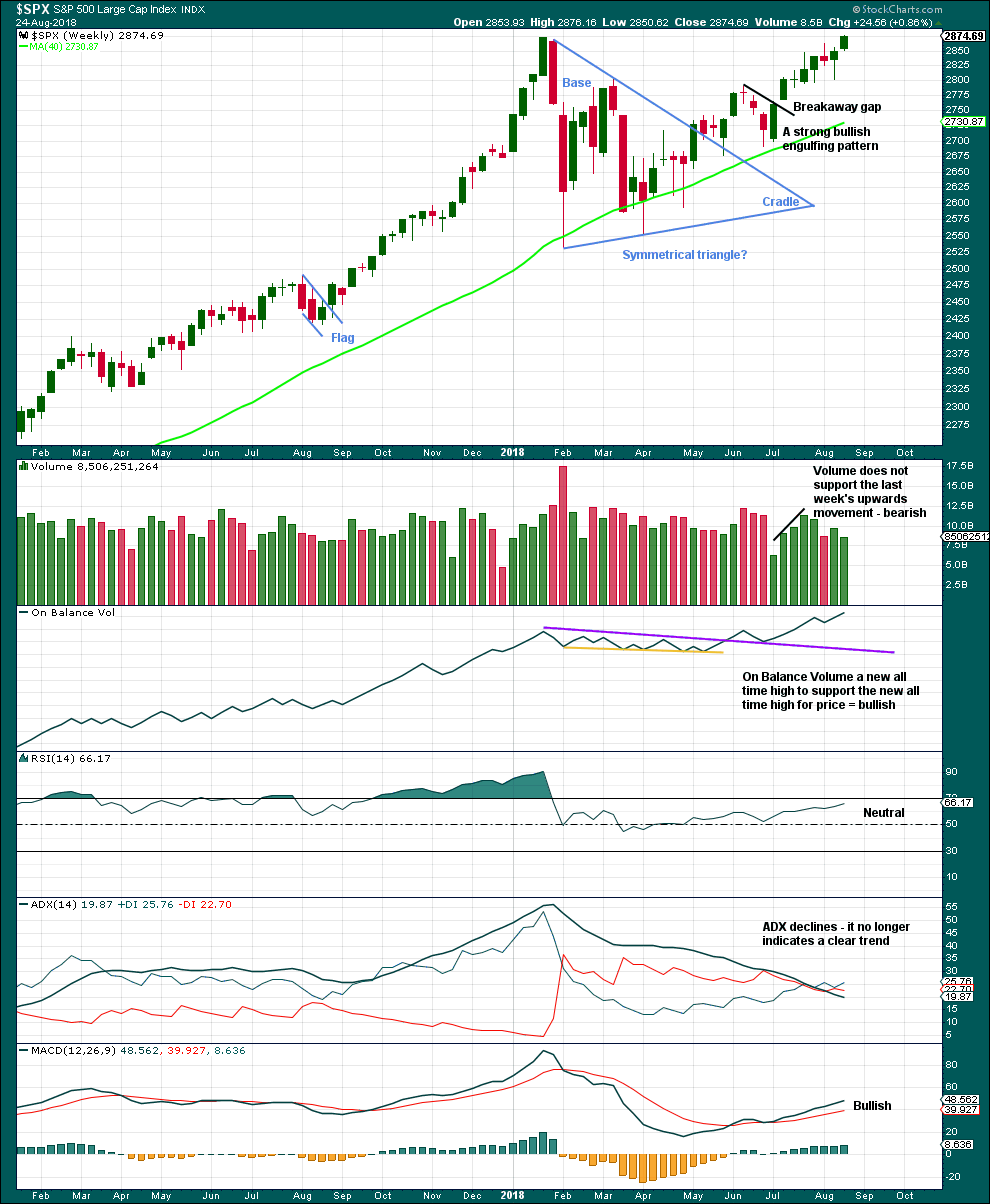
Click chart to enlarge. Chart courtesy of StockCharts.com.
The symmetrical triangle may now be complete. The base distance is 340.18. Added to the breakout point of 2,704.54 this gives a target at 3,044.72. This is above the Elliott wave target at 2,922, so the Elliott wave target may be inadequate.
A new all time high for price has support from another new all time high from On Balance Volume at the weekly chart level, although not at the daily chart level. This is bullish.
Price can rise in current market conditions on light and declining volume for a reasonable period of time, so lighter volume this week does not mean that the rise in price is unsustainable for the short or mid term.
DAILY CHART
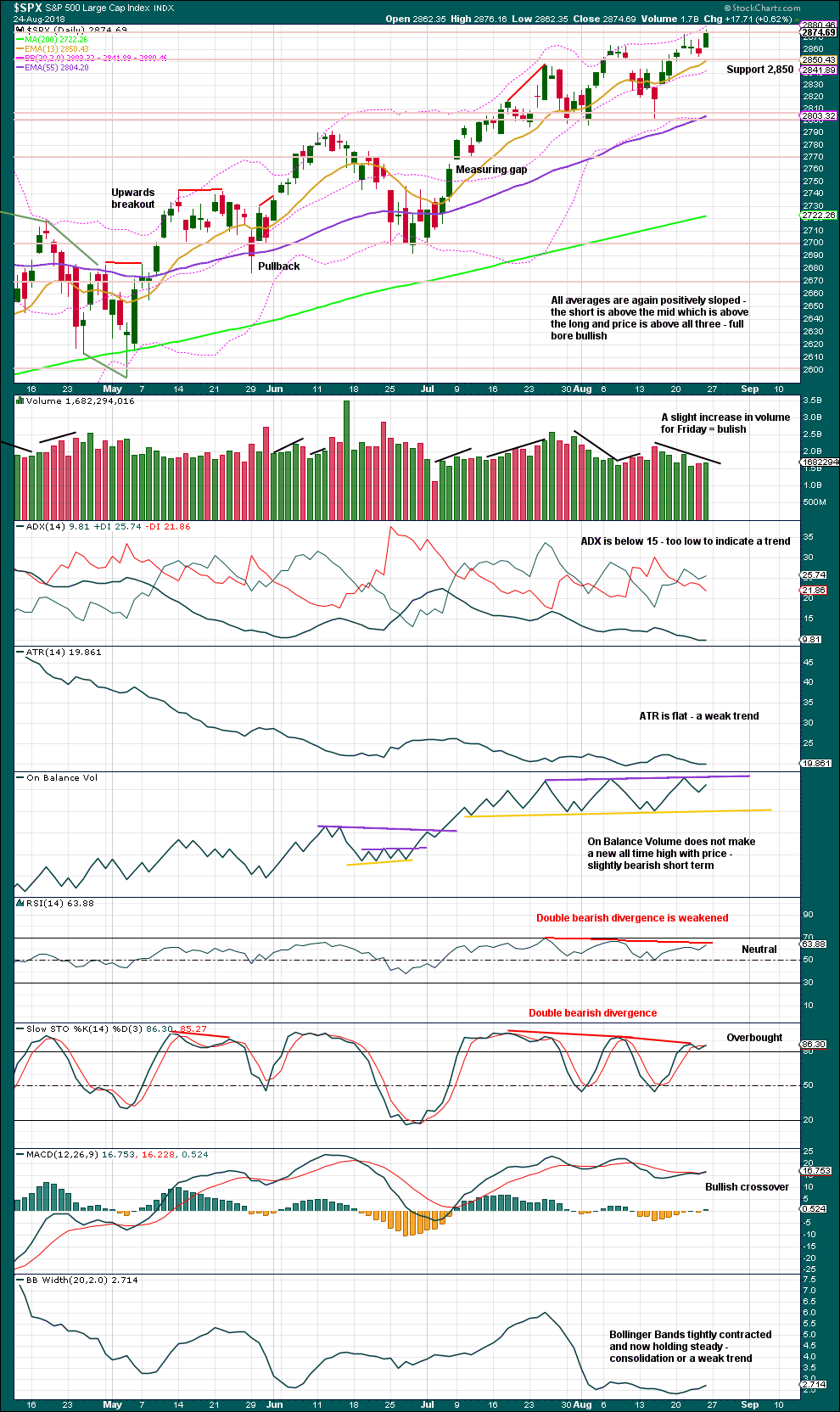
Click chart to enlarge. Chart courtesy of StockCharts.com.
Since the low on the 2nd of April, 2018, price has made a series of higher highs and higher lows. This is the definition of an upwards trend. But trends do not move in perfectly straight lines; there are pullbacks and bounces along the way.
Price has closed at a new all time high with a little support from volume. This is extremely bullish. Look now for support about 2,850.
When On Balance Volume gets up to resistance, then a small consolidation or pullback may develop there. A break above resistance would be another bullish signal.
VOLATILITY – INVERTED VIX CHART
WEEKLY CHART
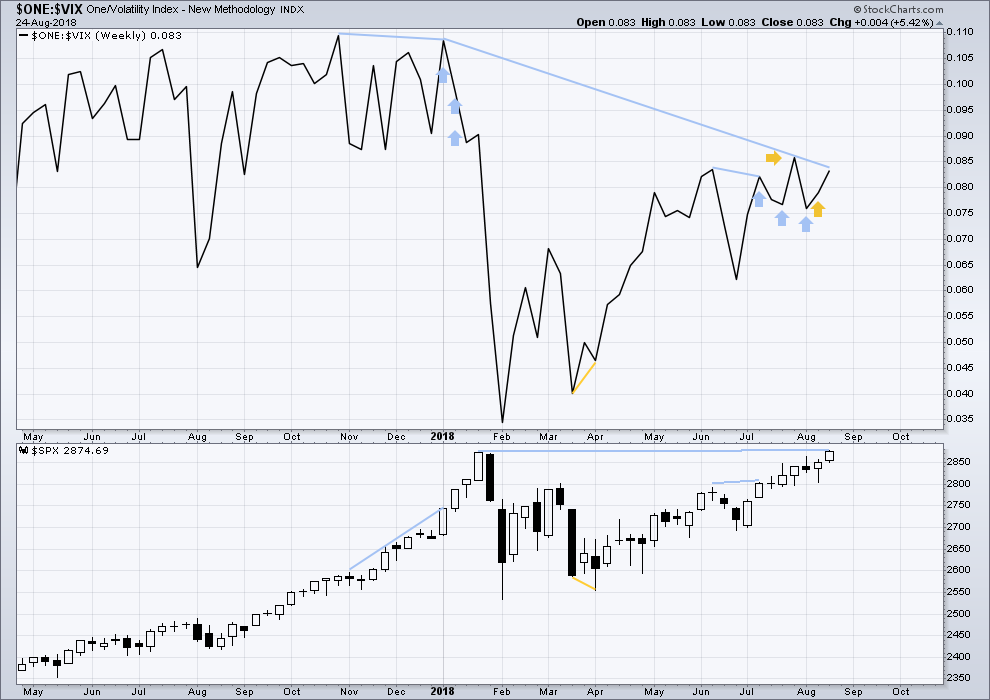
Click chart to enlarge. Chart courtesy of StockCharts.com. So that colour blind members are included, bearish signals
will be noted with blue and bullish signals with yellow.
To keep an eye on the all time high for inverted VIX a weekly chart is required at this time.
Notice how inverted VIX has very strong bearish signals four weeks in a row just before the start of the last large fall in price. At the weekly chart level, this indicator may be useful again in warning of the end of primary wave 3.
At this time, there is mid term bearish divergence between price and inverted VIX: price has made a new all time high, but inverted VIX has not. This divergence may persist for some time and may remain at the end of primary wave 3.
For the short term, upwards movement this week had support from a decline in market volatility. There is no very short term divergence.
DAILY CHART
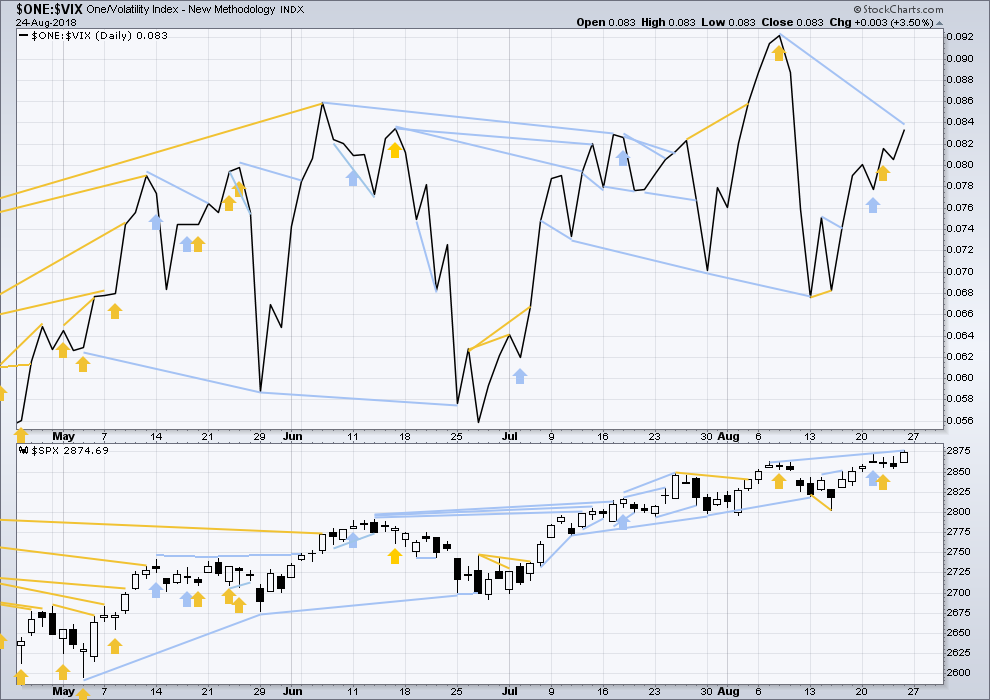
Click chart to enlarge. Chart courtesy of StockCharts.com. So that colour blind members are included, bearish signals
will be noted with blue and bullish signals with yellow.
Normally, volatility should decline as price moves higher and increase as price moves lower. This means that normally inverted VIX should move in the same direction as price.
Last noted bullish short term divergence has now been followed by upwards movement in price, so it may now be resolved.
There is mid term divergence with a new all time high from price not supported by a corresponding new all time high from inverted VIX. This divergence is bearish.
BREADTH – AD LINE
WEEKLY CHART
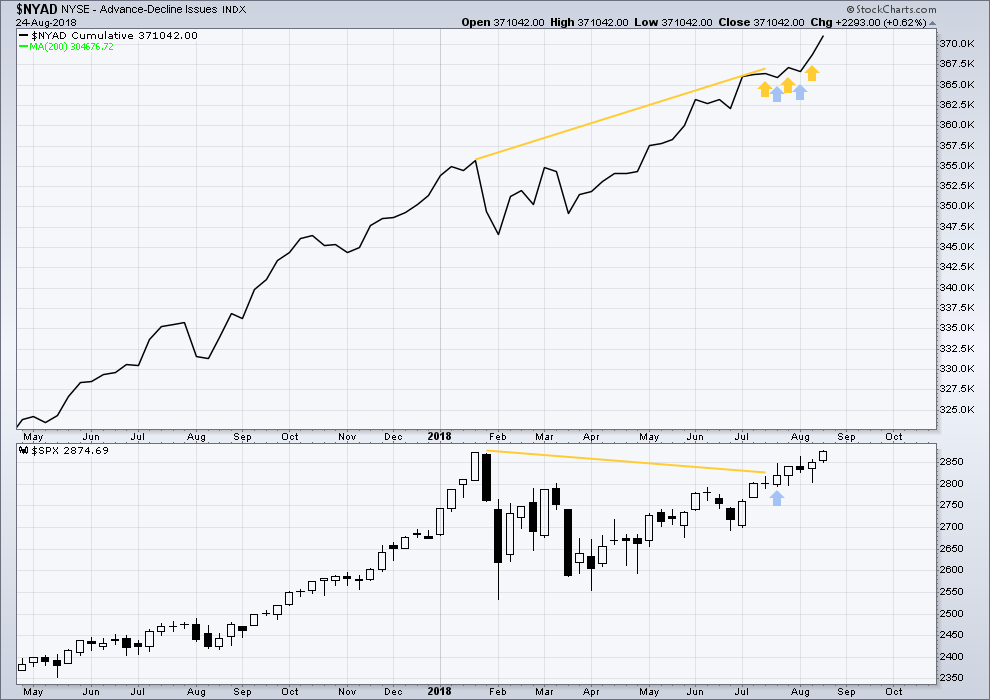
Click chart to enlarge. Chart courtesy of StockCharts.com.
When primary wave 3 comes to an end, it may be valuable to watch the AD line at the weekly time frame as well as the daily.
Strong bullish divergence noted between price and the AD line has finally been followed by a new all time high from price. This divergence may now be resolved, or it may be followed by more upwards movement.
DAILY CHART

Click chart to enlarge. Chart courtesy of StockCharts.com.
There is normally 4-6 months divergence between price and market breadth prior to a full fledged bear market. This has been so for all major bear markets within the last 90 odd years. With no longer term divergence yet at this point, any decline in price should be expected to be a pullback within an ongoing bull market and not necessarily the start of a bear market. New all time highs from the AD line means that any bear market may now be an absolute minimum of 4 months away. It may of course be a lot longer than that. My next expectation for the end of this bull market may now be October 2019.
Breadth should be read as a leading indicator.
The new all time high from price at the end of the week has support from rising market breadth. There is no divergence, which is bullish.
Both large and small caps made a new all time high on Friday but mid caps did not. Mid caps may follow through next week.
Large caps have been the last to make a new all time high; it is normal for large caps to lag in the latter stages of a bull market. This bull market is very aged, but it is not over yet.
DOW THEORY
The following lows need to be exceeded for Dow Theory to confirm the end of the bull market and a change to a bear market:
DJIA: 23,360.29.
DJT: 9,806.79.
S&P500: 2,532.69.
Nasdaq: 6,630.67.
Nasdaq and DJT and now the S&P500 have all made recent new all time highs. For Dow Theory confirmation of the ongoing bull market, DJIA needs to make a new all time high.
GOLD
A strong upwards movement to end the week favours the Elliott wave triangle count. However, to increase the count’s probability, the confidence price point still needs to be passed.
Summary: It is again possible for Gold that a low may be in place, but this needs some confirmation with a new high above 1,216.30. While price remains below 1,216.30, it is possible that the last four sessions are a small bounce within an ongoing downwards trend. A lack of support from volume for this bounce supports this view. If price keeps falling for Gold, expect it to reach below 1,147.
For GDX, a highly significant break below support occurred two weeks ago. The long term target is at 16.02. The small bounce of the last few days now looks to be over, so look out for the downwards trend to most likely resume.
Always trade with stops to protect your account. Risk only 1-5% of equity on any one trade.
Grand SuperCycle analysis is here.
Last historic analysis with monthly charts and several weekly alternates is here, video is here.
Weekly charts will all again be reviewed at the end of this week.
MAIN ELLIOTT WAVE COUNT
WEEKLY CHART – TRIANGLE
There are four remaining weekly wave counts at this time for cycle wave b: a triangle, flat, combination or double zigzag.
All four weekly wave counts will again be considered at the end of this week.
The triangle so far has the best fit and look.
Cycle wave b may be an incomplete triangle. The triangle may be a contracting or barrier triangle, with a contracting triangle looking much more likely because the A-C trend line does not have a strong slope. A contracting triangle could see the B-D trend line have a stronger slope, so that the triangle trend lines converge at a reasonable rate. A barrier triangle would have a B-D trend line that would be essentially flat, and the triangle trend lines would barely converge.
Within a contracting triangle, primary wave D may not move beyond the end of primary wave B below 1,123.08. Within a barrier triangle, primary wave D may end about the same level as primary wave B at 1,123.08, so that the B-D trend line is essentially flat. Only a new low reasonably below 1,123.08 would invalidate the triangle.
Within both a contracting and barrier triangle, primary wave E may not move beyond the end of primary wave C above 1,365.68.
Four of the five sub-waves of a triangle must be zigzags, with only one sub-wave allowed to be a multiple zigzag. Primary wave C is the most common sub-wave to subdivide as a multiple, and this is how primary wave C for this example fits best.
Primary wave D must be a single structure, most likely a zigzag.
There are no problems in terms of subdivisions or rare structures for this wave count. It has an excellent fit and so far a typical look.
A channel is drawn on all charts about the downwards wave of primary wave D. Here, it is labelled a best fit channel. If this channel is breached by upwards movement, that may provide reasonable confidence in this weekly triangle wave count and put serious doubt on the other three weekly wave counts.
This wave count now expects a consolidation for primary wave E to back test resistance at prior support, and then a significant new downwards wave for cycle wave C. For the long term, this is the most bearish wave count.
DAILY CHART – TRIANGLE
Primary wave D may again be complete. For Barchart data, there is a Morning Doji Star candlestick reversal pattern at the low.
A new high above 1,216.30 would be required for reasonable confidence that a low is in place. This price point is the start of minor wave 5. A new high above the start of minor wave 5 may not be a second wave correction within minor wave 5, so at that stage minor wave 5 should be over.
While price remains below 1,216.30, it will remain possible that primary wave D could continue lower. However, primary wave D for this triangle wave count should end here or very soon, so that the B-D trend line has a reasonable slope ensuring the triangle trend lines converge at a reasonable rate. If primary wave D were to continue much lower, the B-D trend line would have too shallow a slope for a normal looking Elliott wave triangle.
A target for primary wave E is the strong zone of resistance about 1,305 to 1,310. Primary wave E is most likely to subdivide as a zigzag (although it may also subdivide as a triangle to create a rare nine wave triangle), and it should last at least a Fibonacci 13 weeks. Primary wave E may not move beyond the end of primary wave C above 1,365.68.
WEEKLY CHART – COMBINATION
It is essential when a triangle is considered to always consider alternates. Too many times over the years I have labelled a triangle as unfolding or even complete, only for it to be invalidated and the structure turning out to be something else.
When a triangle is invalidated, then the most common structure the correction turns out to be is a combination.
If cycle wave b is a combination, then the first structure in a double may be a complete zigzag labelled primary wave W.
The double may be joined by a three in the opposite direction, a zigzag labelled primary wave X.
The second structure in the double may be a flat correction labelled primary wave Y. My research on Gold so far has found that the most common two structures in a double combination are one zigzag and one flat correction. I have found only one instance where a triangle unfolded for wave Y. The most likely structure for wave Y would be a flat correction by a very wide margin, so that is what this wave count shall expect.
Within a flat correction for primary wave Y, the current downwards wave of intermediate wave (B) may be a single or multiple zigzag; for now it shall be labelled as a single. Intermediate wave (B) must retrace a minimum 0.9 length of intermediate wave (A) at 1,147.34. Intermediate wave (B) may move beyond the start of intermediate wave (A) as in an expanded flat.
Because the minimum requirement for intermediate wave (B) is not yet met, this wave count requires that minute wave v of minor wave C of intermediate wave (B) continues lower. This is the most immediately bearish of all four weekly wave counts.
When intermediate wave (B) is complete, then intermediate wave (C) would be expected to make at least a slight new high above the end of intermediate wave (A) at 1,365.68 to avoid a truncation. Primary wave Y would be most likely to end about the same level as primary wave W at 1,374.91, so that the whole structure takes up time and moves price sideways, as that is the purpose of double combinations.
While double combinations are very common, triples are extremely rare. I have found no examples of triple combinations for Gold at daily chart time frames or higher back to 1976. When the second structure in a double is complete, then it is extremely likely (almost certain) that the whole correction is over.
DAILY CHART – COMBINATION
It is time to follow this wave count at daily time frame as it now diverges from the other wave counts.
Minor wave C of intermediate wave (B) may be an incomplete five wave impulse. Within the impulse, minute waves i, ii, iii and iv may all be complete and minute wave v may now be unfolding.
Within minute wave v, the current small bounce may be minuette wave (ii), which may not move beyond the start of minuette wave (i) above 1,216.30.
WEEKLY CHART – FLAT
It is possible that cycle wave b may be a flat correction. Within a flat correction, primary wave B must retrace a minimum 0.9 length of primary wave A at 1,079.13 or below. Primary wave B may make a new low below the start of primary wave A at 1,046.27 as in an expanded flat correction.
Only a new low reasonably below 1,123.08 would provide reasonable confidence in this wave count.
Intermediate wave (C) must subdivide as a five wave structure; it may be unfolding as an impulse. Within intermediate wave (C), minor waves 1, 2 and now 3 may be complete. A consolidation to last about 5 to 13 weeks may now develop for minor wave 4. Minor wave 4 may not move into minor wave 1 price territory above 1,307.09.
This wave count differs from the triangle wave count in that it expects a possibly more brief and more shallow correction to unfold here.
The blue channel here is drawn using Elliott’s first technique. Minor wave 4 would be most likely to remain contained within this channel, and may find resistance about the upper edge if it gets there. A strong breach of this channel by upwards movement would reduce the probability of this wave count.
Minor wave 2 was a double zigzag lasting nine weeks. To exhibit alternation and reasonable proportion minor wave 4 may be a flat, combination or triangle and may last a little longer than nine weeks as these types of corrections can be longer lasting than zigzags or zigzag multiples.
WEEKLY CHART – DOUBLE ZIGZAG
Finally, it is also possible that cycle wave b may be a double zigzag or a double combination.
The first zigzag in the double is labelled primary wave W. This has a good fit.
The double may be joined by a corrective structure in the opposite direction, a triangle labelled primary wave X. The triangle would be about two thirds complete.
Within the triangle of primary wave X, intermediate wave (C) may now be complete. It may not move beyond the end of intermediate wave (A) below 1,123.08. The A-C trend line for both a barrier and contracting triangle should have some reasonable slope. For the triangle of primary wave X to have the right look, intermediate wave (C) should end here or very soon indeed.
This wave count may now expect choppy overlapping movement in an ever decreasing range for several more months. After the triangle is complete, then an upwards breakout would be expected from it.
Primary wave Y would most likely be a zigzag because primary wave X would be shallow; double zigzags normally have relatively shallow X waves.
Primary wave Y may also be a flat correction if cycle wave b is a double combination, but combinations normally have deep X waves. This would be less likely.
This wave count has good proportions and no problems in terms of subdivisions.
TECHNICAL ANALYSIS
WEEKLY CHART
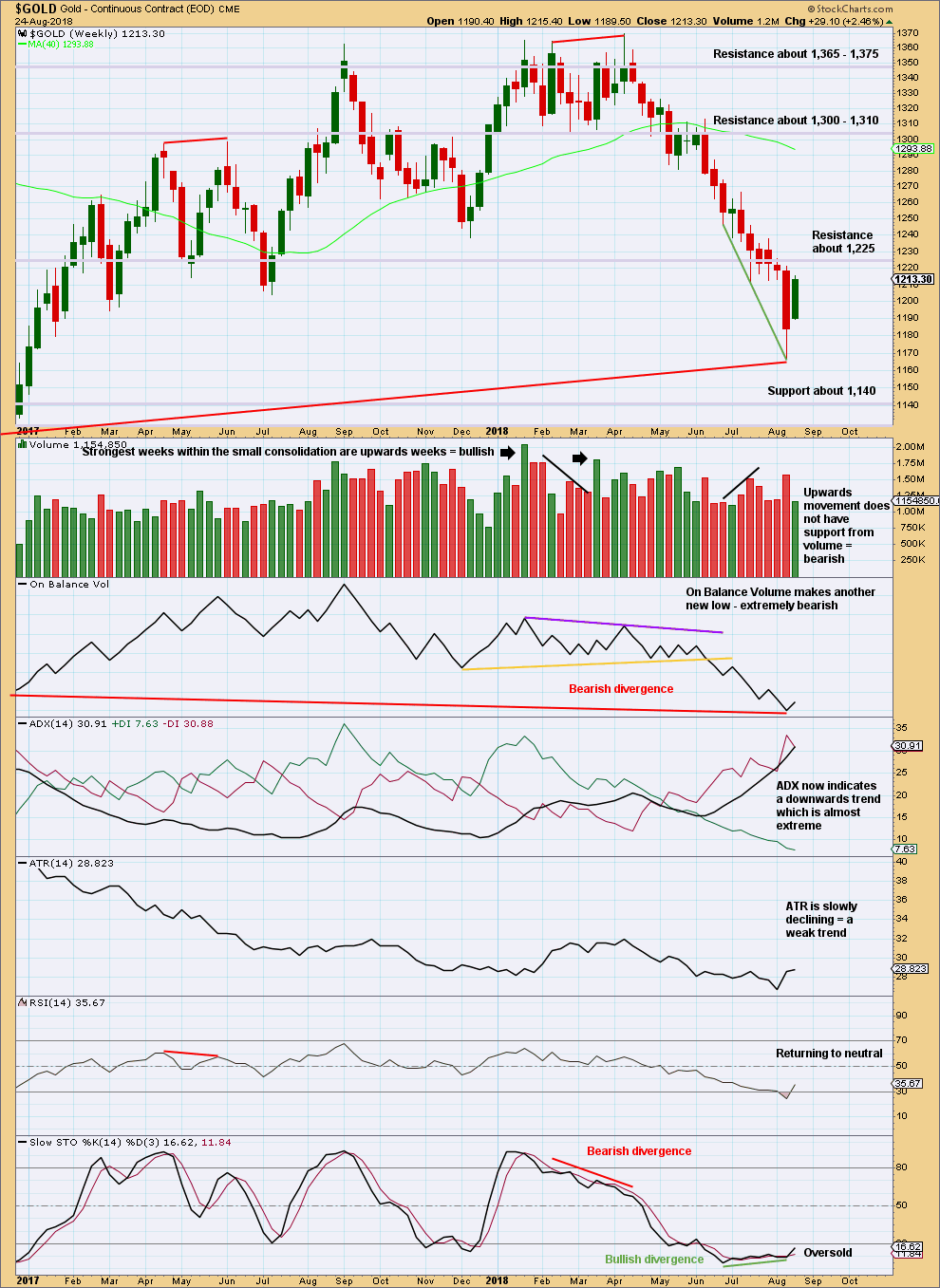
Click chart to enlarge. Chart courtesy of StockCharts.com.
On Balance Volume is lower than its prior point at the end of November 2015. This divergence is extremely bearish but does not rule out a consolidation unfolding here; the divergence does strongly support the Triangle wave count, which expects a consolidation or bounce up to test resistance now and then a continuation of a major bear market.
When Gold has a strong trend, ADX may remain very extreme for long periods of time and RSI can move more deeply into oversold. However, most recent lows since November 2015 were all found when RSI just reached oversold, so some caution here in looking out for a possible consolidation or trend change would be reasonable.
A reasonable upwards week this week looks like either a small consolidation within an ongoing downwards trend or the start of a new upwards trend. The lack of support from volume suggests a consolidation.
If price does continue lower, then look for next support about 1,140.
DAILY CHART

Click chart to enlarge. Chart courtesy of StockCharts.com.
A downwards breakout below the Pennant pattern has support from volume. The target using the length of the flagpole which precedes the Pennant is 1,157. This target was not met.
Support below is now about 1,140.
When a trend is very extreme, it is time to look out for candlestick reversal patterns and a possible trend reversal to the opposite direction, or a reasonable sideways move to relieve extreme conditions. Here, there is a Hammer reversal pattern at the low (it is almost a Dragonfly doji, but there is a little too great an upper shadow for that pattern). This is a warning that a low may now be in place.
Friday’s upwards day is fairly strong and has good support from volume. There is now rising price with rising volume that now looks more bullish.
GDX WEEKLY CHART
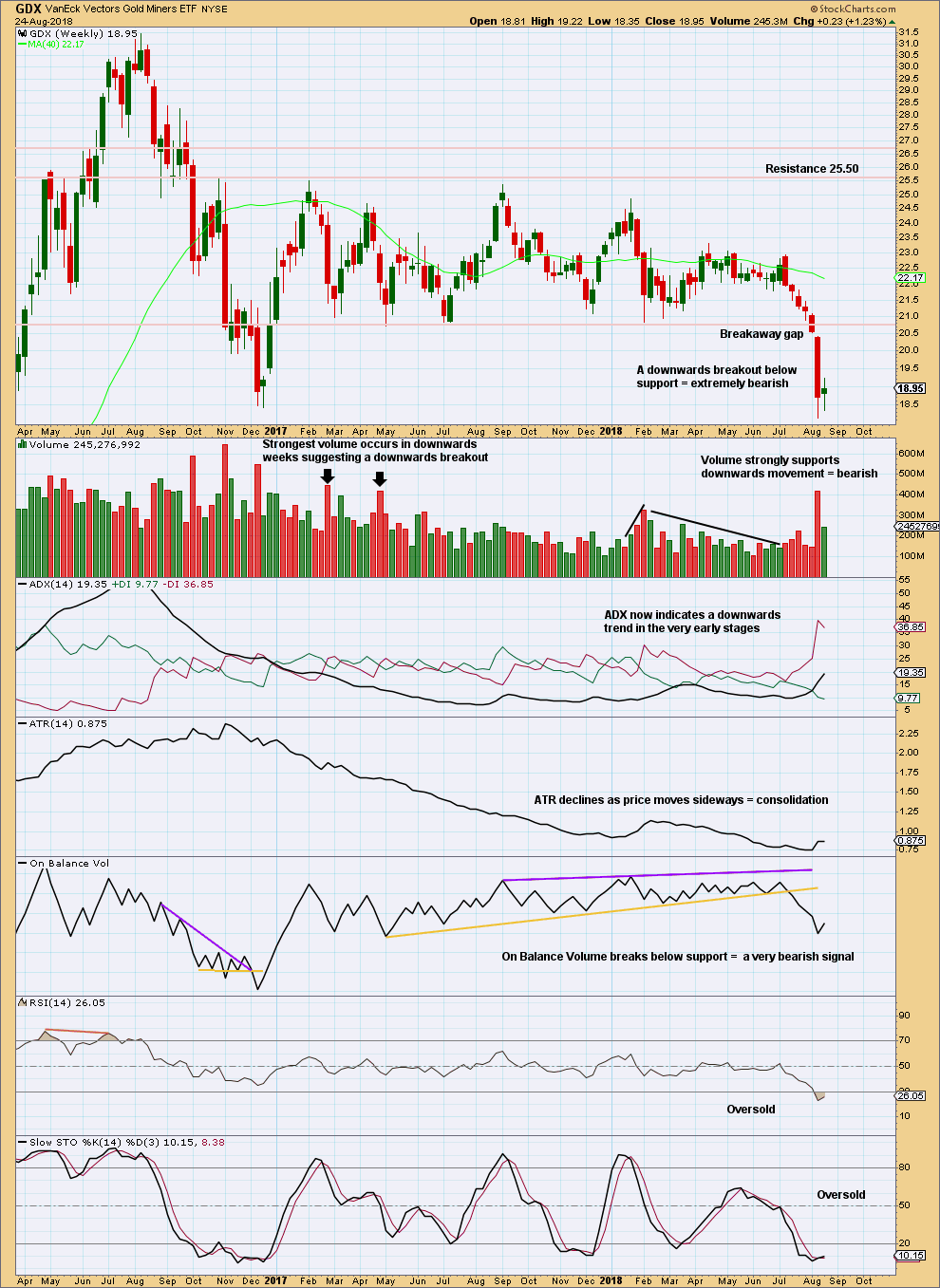
Click chart to enlarge. Chart courtesy of StockCharts.com.
GDX is now moving lower exactly as expected.
After a breakout, a technical principle is the longer that price consolidates sideways the longer the resulting trend may be expected to be. Also, the longer that price meanders sideways the more energy may be released after a breakout. This is what is happening now for GDX.
The target for this downwards trend to end is calculated using the measured rule. The widest part of the consolidation is added to the breakout point at 20.80 giving a target at 16.02. That is not yet met.
At the weekly chart level, there is a clear downwards breakout with a breakaway gap. As breakaway gaps should not be closed, they may be used to set stops that may be set just above a downwards breakaway gap.
Upwards movement for this last week may be the start of a bounce to back test resistance.
GDX DAILY CHART
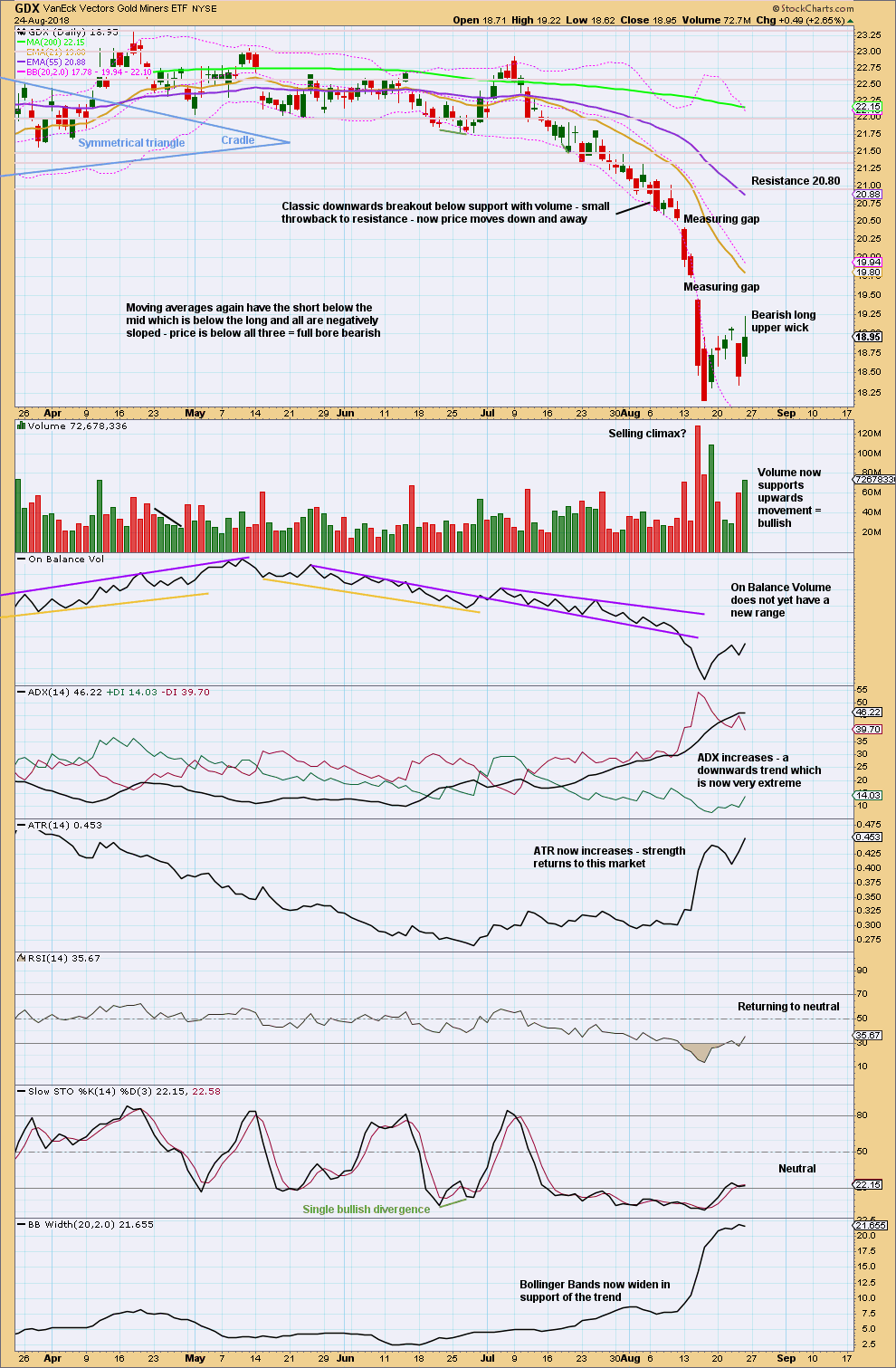
Click chart to enlarge. Chart courtesy of StockCharts.com.
GDX has now closed below support on a strong downwards day with support from volume. New lows are the lowest for GDX since December 2016. This is extremely significant for GDX.
GDX is in a downwards trend. Bounces and consolidations may be used as opportunities to join the trend. The bounce looked weak up until Friday. Now with support from volume for upwards movement the bounce may be incomplete.
The last measuring gap may provide resistance. A closure of this gap with a new high above 19.74 would be significant; at that stage, it would not be a measuring gap but an exhaustion gap. Assume it is a measuring gap, until proven otherwise.
Looking back over the last 3 1/2 years at GDX, at the daily chart level, I see it can reach extreme levels and remain there while price continues to move a reasonable distance. Only when it has reached very extreme and then exhibits strong divergence may an end to a strong trend be indicated. I would advise members trading GDX at this time to take some time to look over price action of the last few years, with ADX and RSI especially, and study carefully what happened towards at the end of strong trends.
Please remember to protect your trading accounts by careful risk management. Follow my two Golden Rules:
1. Always trade with stops.
2. Risk only 1-5% of equity on any one trade.
A possible target for this downwards trend to end may be now calculated using the measured rule, giving a target about 16.02.
US OIL
A little more downwards movement was expected for the week but did not happen. Price remains within a consolidation zone.
Summary: The Elliott wave structure for intermediate wave (4) does not look complete. It may continue sideways now for another 8 weeks.
The larger trend remains upwards, so pullbacks may be used as opportunities to join the trend.
Always practice good risk management as the most important aspect of trading. Always trade with stops and invest only 1-5% of equity on any one trade. Failure to manage risk is the most common mistake new traders make.
MAIN WAVE COUNT
MONTHLY CHART
The bear market for US Oil looks to be over and a new bull market looks to be in its early stages. The prior bearish wave count has been invalidated, leaving only this very bullish wave count.
A huge zigzag down to the last low may be complete and is labelled here Super Cycle wave (II).
Cycle wave b must be seen as complete in August 2013 for this wave count to work. It cannot be seen as complete at the prior major swing high in May 2011.
Cycle wave b is seen as a zigzag, and within it primary wave B is seen as a running contracting triangle. These are fairly common structures, although nine wave triangles are uncommon. All subdivisions fit.
Primary wave C moves beyond the end of primary wave A, so it avoids a truncation. But it does not have to move above the price territory of primary wave B to avoid a truncation, which is an important distinction.
If cycle wave b begins there, then cycle wave c may be seen as a complete five wave impulse.
Super Cycle wave (III) must move beyond the end of Super Cycle wave (I). It must move far enough above that point to allow room for a subsequent Super Cycle wave (IV) to unfold and remain above Super Cycle wave (I) price territory.
Cycle wave I may be incomplete. It may be unfolding as an impulse and may have now moved through the middle portion. Commodities have a tendency to exhibit swift strong fifth waves, and this tendency is especially prevalent for third wave impulses. Intermediate wave (5) to end primary wave 3 may be very swift and strong, ending with a blow off top.
When cycle wave I is complete, then cycle wave II may be a deep correction that may not move beyond the start of cycle wave I below 26.06.
Data from FXCM for USOil does not go back to the beginning of Super Cycle wave (I). Without an accurate known length of Super Cycle wave (I) a target cannot be calculated for Super Cycle wave (III) to end using Fibonacci ratios. The target for Super Cycle wave (III) may be calculated when cycle waves I, II, III and IV within it are complete. That cannot be done for many years.
WEEKLY CHART
Intermediate wave (3) may now be complete. There is no Fibonacci ratio between intermediate waves (1) and (3), and intermediate wave (3) is longer than 1.618 the length of intermediate wave (1).
This wave count fits with classic technical analysis at the monthly and daily chart levels.
Intermediate wave (2) was a deep double zigzag. Given the guideline of alternation, intermediate wave (4) may be expected to most likely be a shallow flat, triangle or combination. It may be about even in duration with intermediate wave (2), or it may be a little longer because triangles and combinations are more time consuming structures.
Intermediate wave (4) has now lasted a Fibonacci 13 weeks. At the daily chart level, at this stage, I cannot see it as a complete corrective structure. The next expectation will now be for it to possibly complete in a further 8 weeks to total a Fibonacci 21. It may not exhibit a Fibonacci duration though (this is a rough guideline only).
Intermediate wave (4) may find support about the lower edge of the black Elliott channel. It may end within the price territory of the fourth wave of one lesser degree; minor wave 4 has its territory from 66.65 to 59.13.
At this stage, only two structural options fit for intermediate wave (4) at the daily chart level: a triangle and a combination. They are both equally valid and have about an even probability.
Because the last wave down to support, ending on the 16th of August, now looks like a complete structure and will only subdivide as a three, it cannot be wave C of a flat correction. For this reason, a flat correction at this time does not fit and has been discarded.
COMBINATION
Intermediate wave (4) may be unfolding as a double combination.
This wave count is adjusted this week to have a slightly better fit.
The first structure in a double combination may be a complete zigzag labelled minor wave W. There is a little disproportion within minute wave a between the corrections of minuette waves (ii) and (iv), but this is slight enough to be acceptable for this market.
The double is joined by a complete three in the opposite direction, a zigzag labelled minor wave X. X waves within combinations have no minimum nor maximum allowable length, and may make new price extremes beyond the start of wave W as this one does. The only guideline in terms of depth for X waves is that they are normally very deep.
The second structure in a double combination would most likely be a flat correction as the two most common structures in a double combination are one zigzag and one flat.
Within a possible flat correction for minor wave Y, minute wave a now looks like a completed three. Minute wave b must now retrace a minimum 0.9 length of minute wave a, and it may move beyond the start of minute wave a as in an expanded flat. Minute wave b should exhibit clear weakness, should exhibit lack of support from volume, and at its end should exhibit some divergence between price and either or both of Stochastics and RSI.
When minute wave b is complete, then minute wave c would need to end at least slightly below the end of minute wave a at 64.43 to avoid a truncation.
The purpose of the second structure in a double combination is to take up time and move price sideways. To achieve this purpose minor wave Y would be most likely to end about the same level as minor wave W about 63.60.
TRIANGLE
Intermediate wave (4) may be unfolding as a triangle.
Subdivisions for this wave count this week are relabelled. Minor wave A is now seen as a single zigzag, which has a reasonable look. Minor wave B is now also seen as a single zigzag, which has a better look.
Minor wave C may have been a complete double zigzag, which has a very good fit. C waves are the most common triangle sub-waves to subdivide as a multiple, so this labelling fits with a common pattern.
Minor wave D within a contracting triangle may not move beyond the end of minor wave B above 75.26. The A-C trend line has a shallow slope, so the upper B-D trend line should have a reasonable slope for the triangle trend lines to have a reasonable rate of convergence. A contracting triangle would have a sloping B-D trend line, so this looks most likely. One of a triangles five sub-waves is usually about 0.618 the length of the prior sub-wave; this gives a possible target for minor wave D.
Minor wave D within a barrier triangle may end about the same level as minor wave B at about 75.26, so that the B-D trend line is essentially flat. A barrier triangle here would not produce triangle trend lines that converge at a reasonable rate. This would not have the right look. A barrier triangle looks unlikely.
When minor wave D is a complete zigzag, then a final zigzag down for minor wave E would most likely end reasonably short of the A-C trend line. Minor wave E may not move beyond the end of minor wave C below 64.43.
TECHNICAL ANALYSIS
MONTHLY CHART
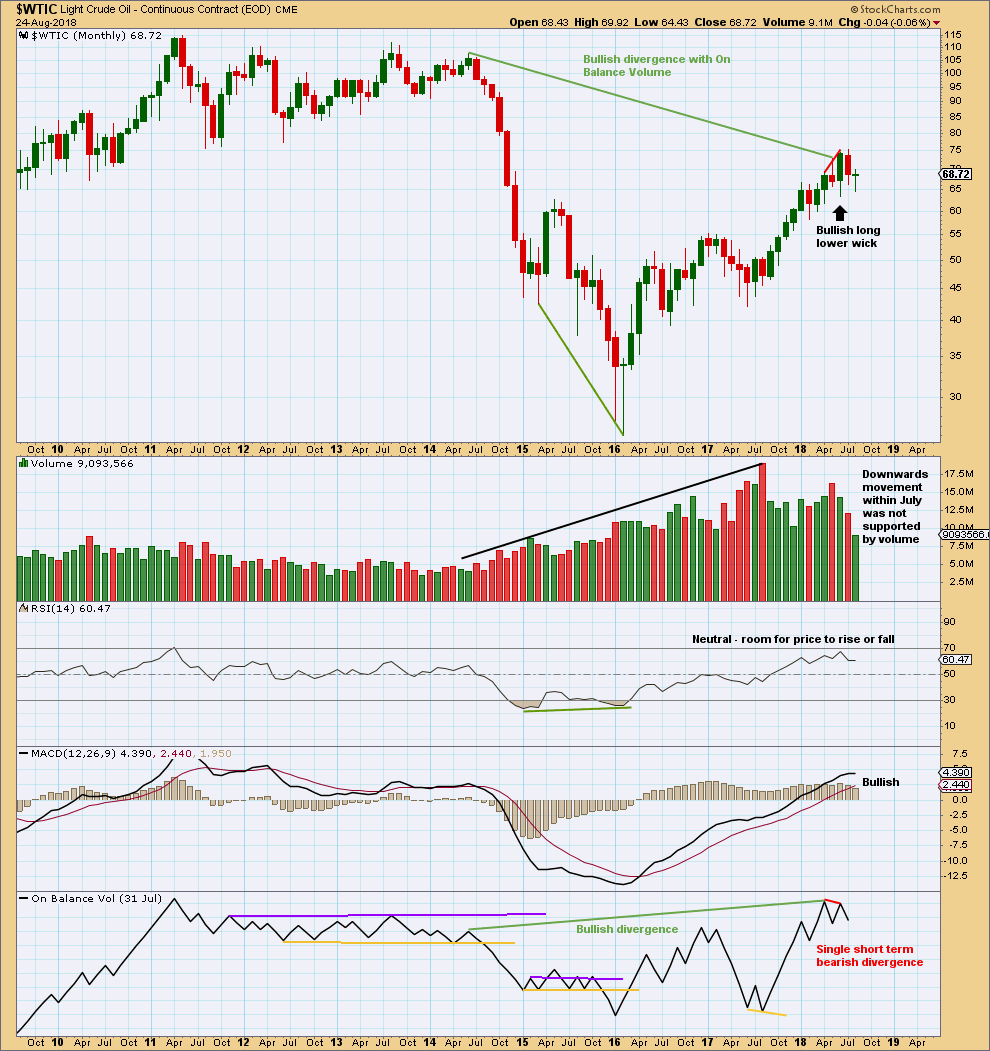
Click chart to enlarge. Chart courtesy of StockCharts.com.
The short term volume profile is bearish: the strongest month in the last few months was the downwards month of May (where the balance of volume was down) and now June shows a decline in volume, so volume has not supported upwards movement here.
July saw another red monthly candlestick with the balance of volume downwards, but the market fell of its own weight; it was not supported by volume. This is not necessarily bullish, but it does point to a consolidation as somewhat more likely here.
For the short term, On Balance Volume is also slightly bearish. This supports the idea that price may be within a correction and not necessarily a continuation of the larger upwards trend.
However, it is entirely possible that this situation could reverse and volume could start to support upwards movement, as has happened back in January 2018.
The larger trend is upwards.
WEEKLY CHART

Click chart to enlarge. Chart courtesy of StockCharts.com.
An upwards week with an increased ATR and support from volume is short term bullish.
On Balance Volume is still more bearish than bullish. Adjusted trend lines here may be expected to provide support and resistance, in the first instance, and then a breakout would provide a signal.
DAILY CHART

Click chart to enlarge. Chart courtesy of StockCharts.com.
This chart looks bullish for the short term. Look for resistance about 72.50 and then 75.30.
Look for On Balance Volume to possibly find resistance at the yellow line. A break above this line would be a weak bullish signal. The line has only been tested three times, so it holds only weak technical significance.


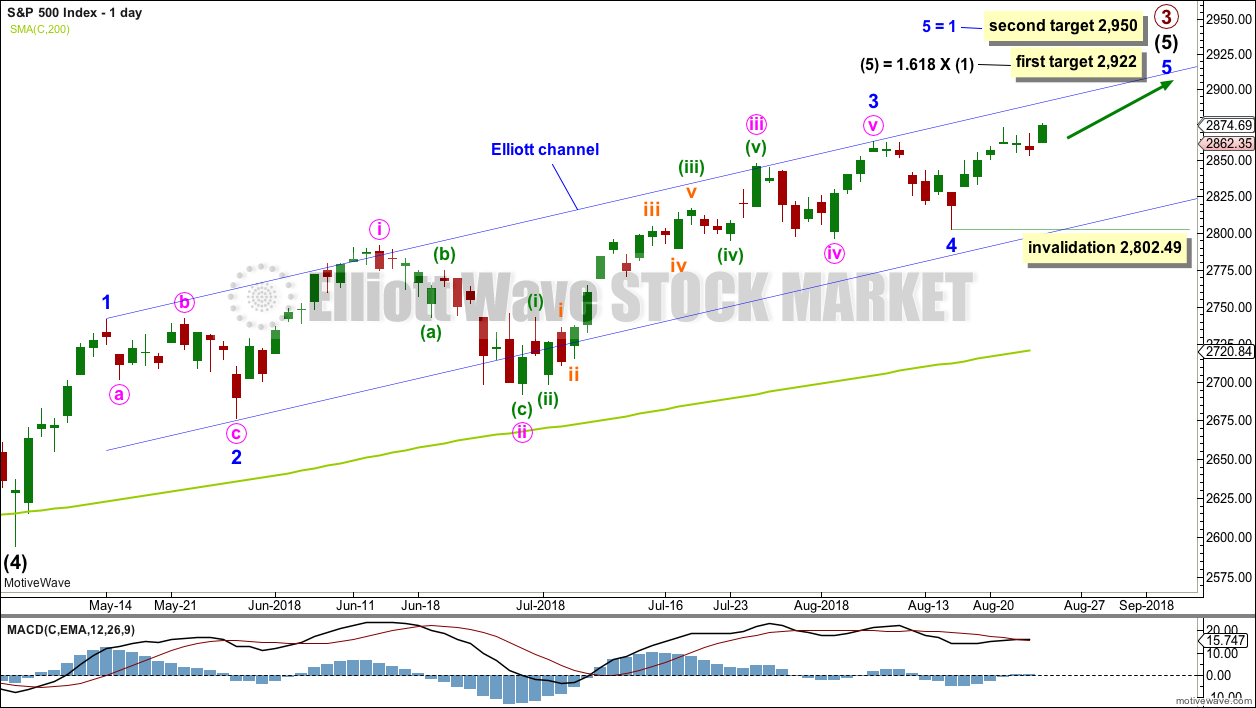
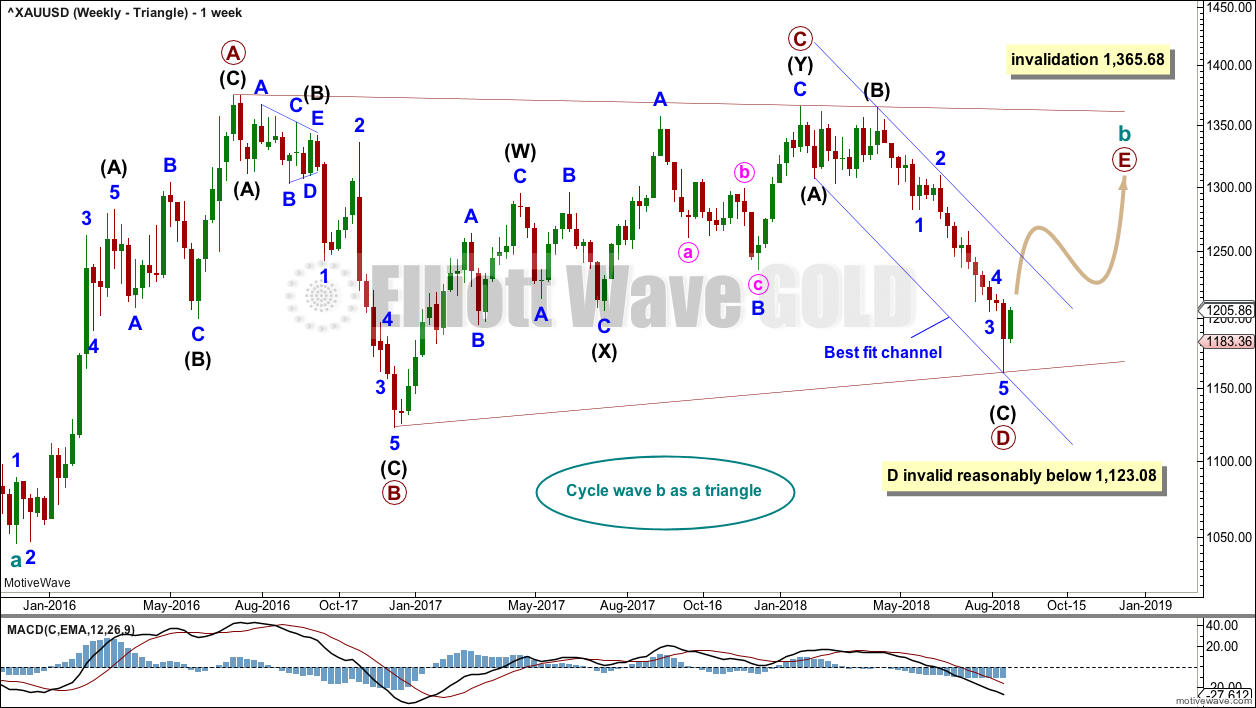
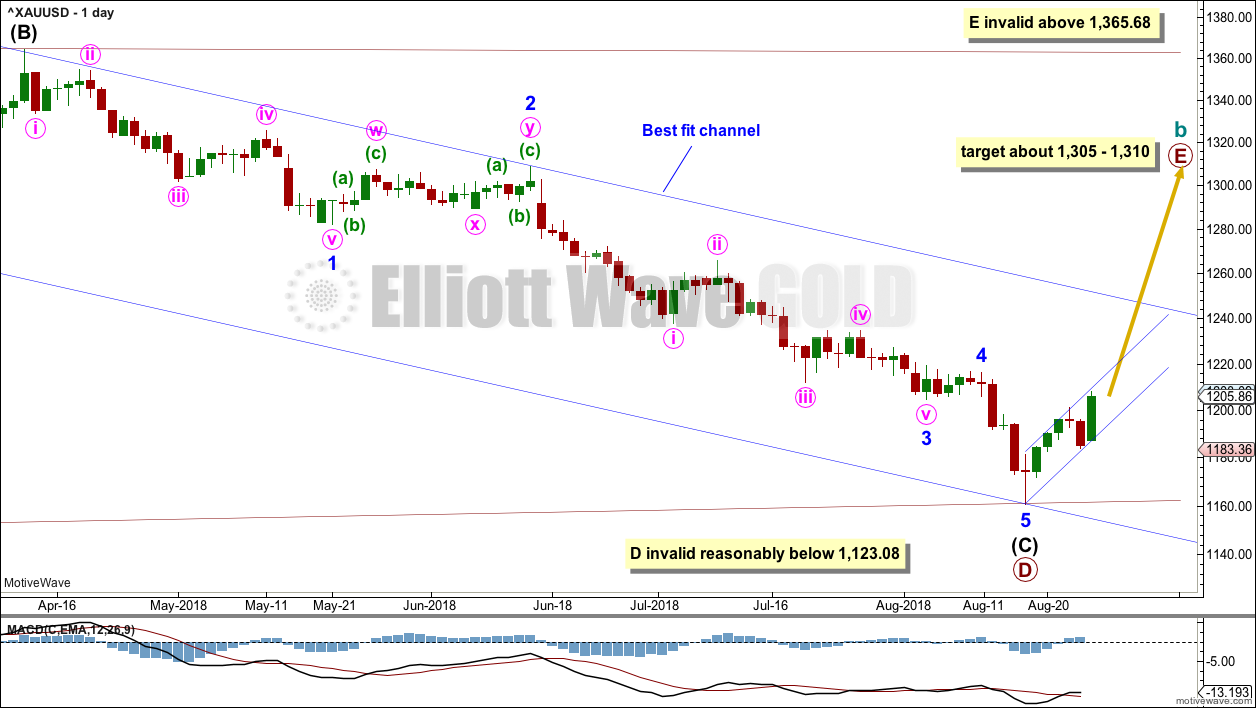
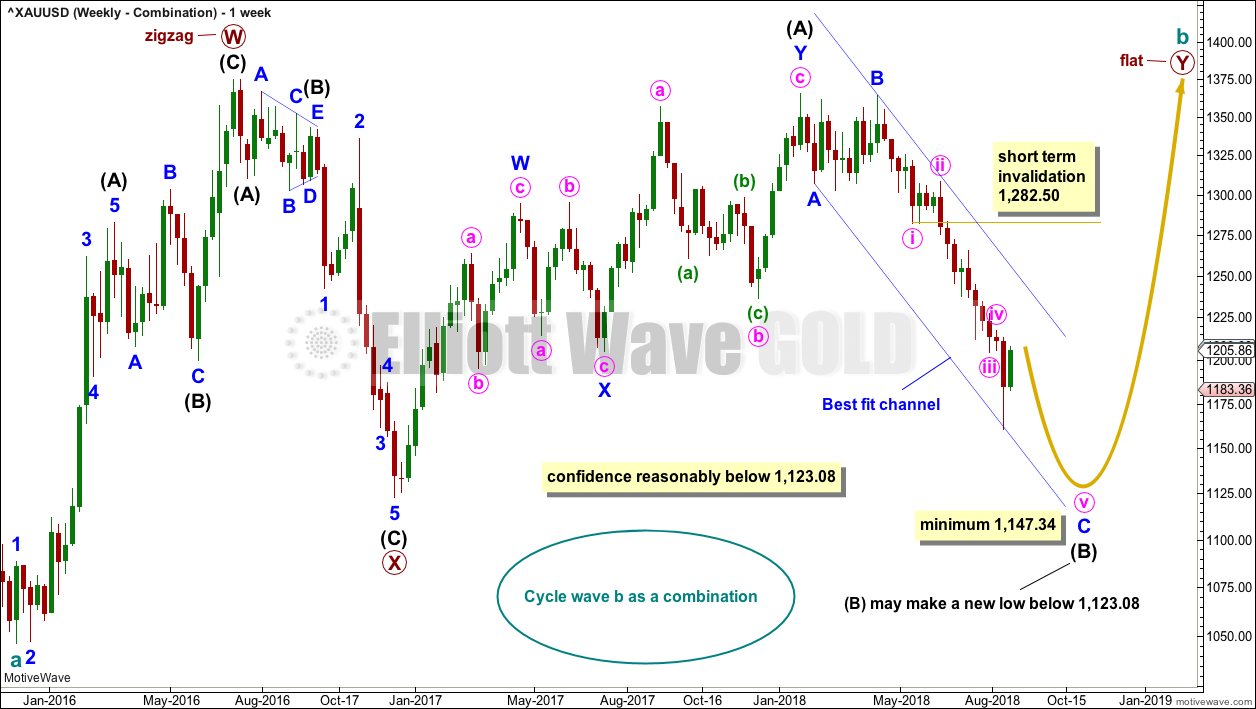
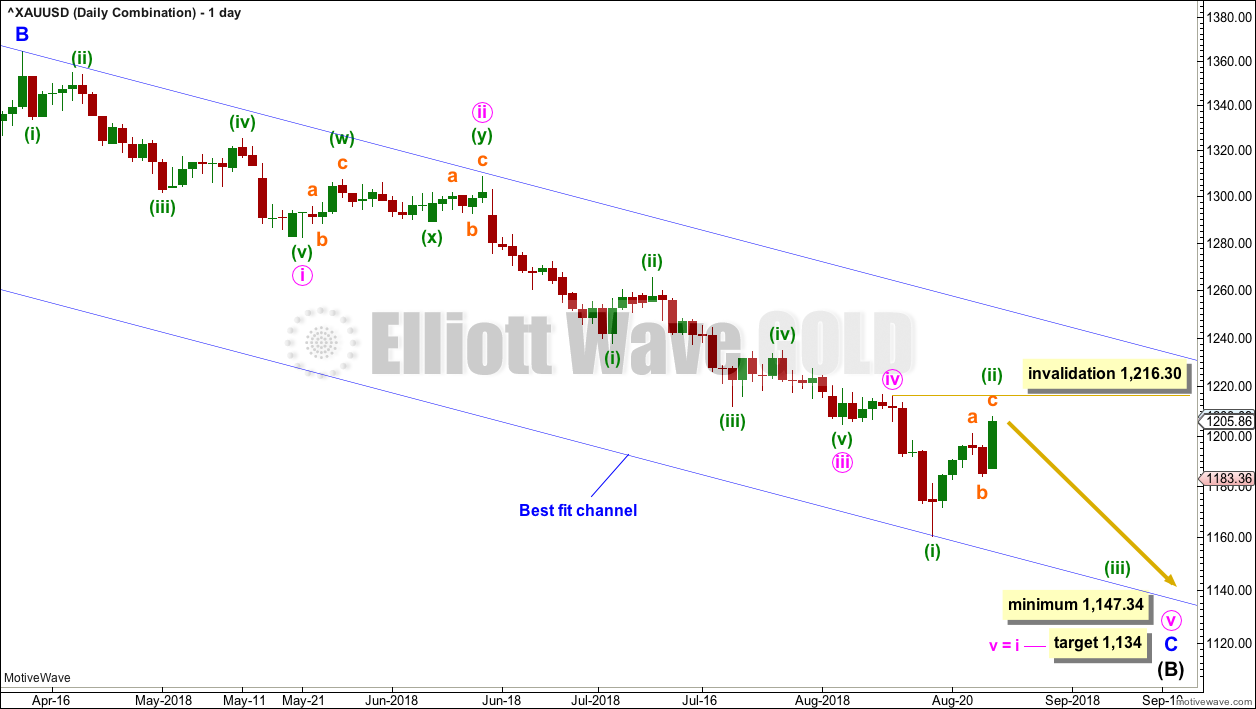
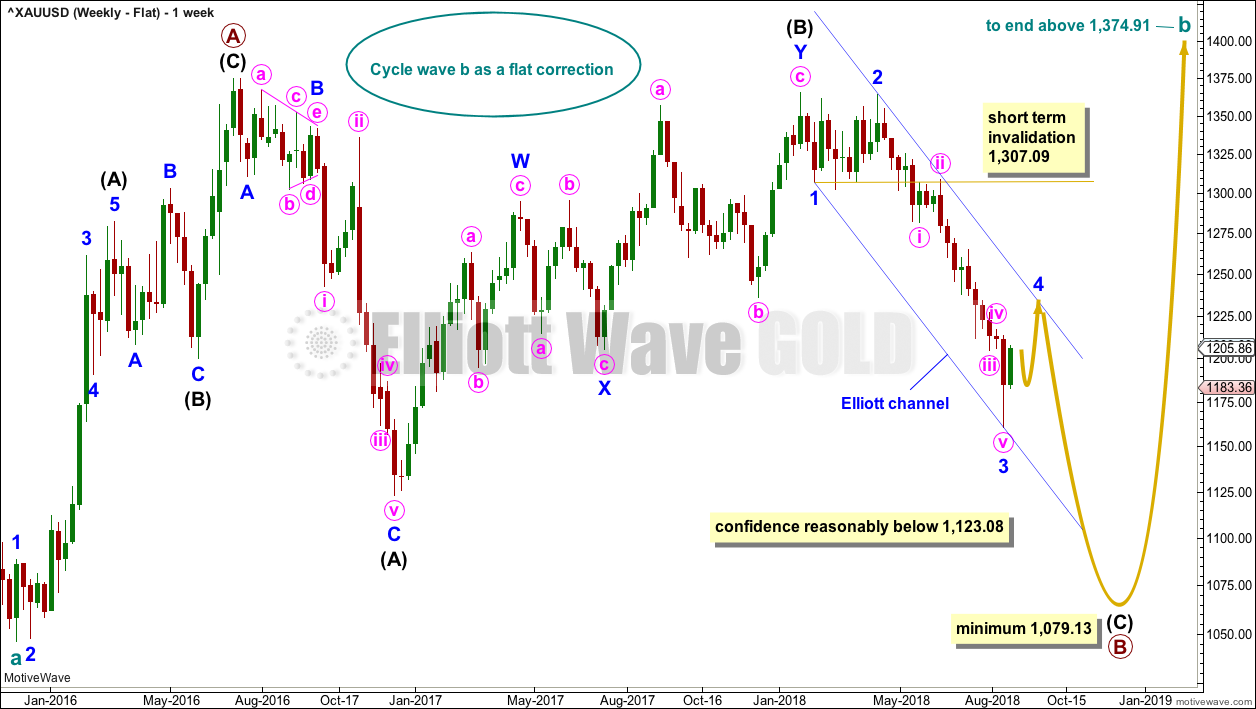
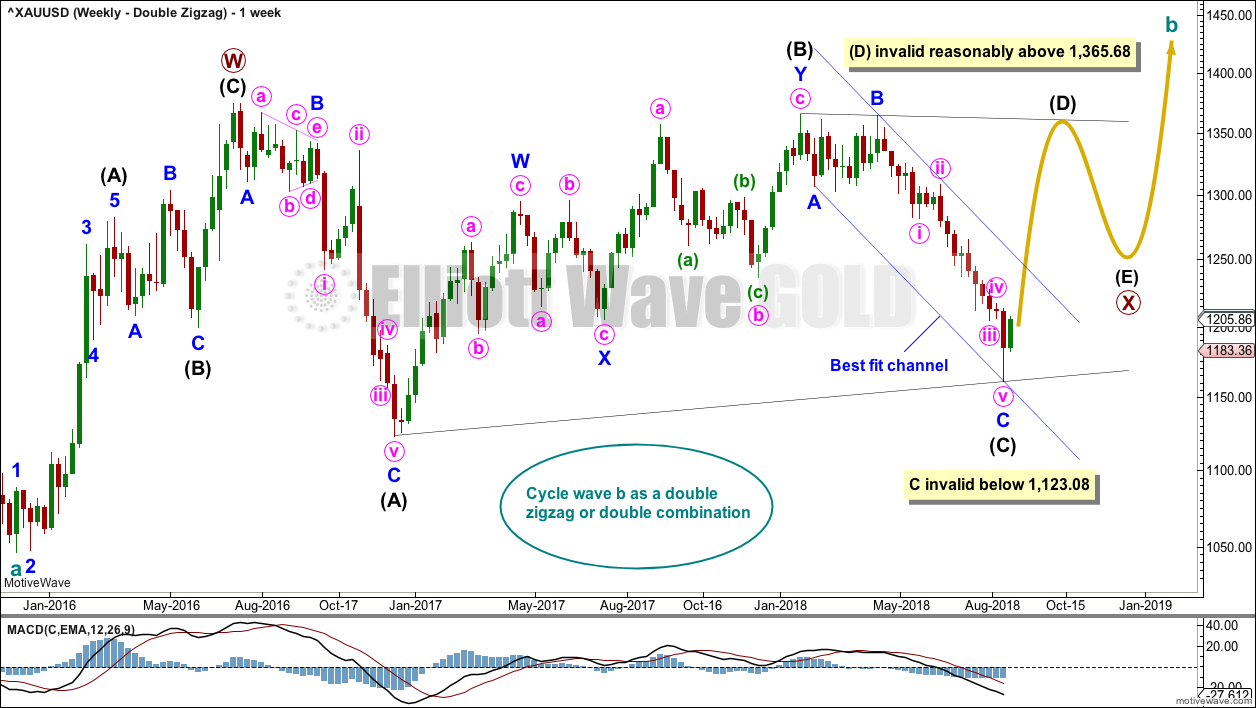




Lara
On the S&P, an interesting analysis this week as always. For those of us getting weekly updates, the update on August 17th your main wave count still had minor wave 3 incomplete and minute wave IV most likely a running contracting triangle that may have been almost complete. You did point out at that time that minute wave IV could have been over and minor wave 3 could have ended at the last high. This is apparently what you have concluded in this recent analysis. Then minute wave IV, minor wave 3 and 4 have all shifted back one degree.
So now we can expect when minor wave 5 ends (as well as primary wave 3), a potentially deep multi week or multi month correction will start. I want to be clear on this as obviously this is a critical development as opposed to last weeks analysis where we could have expected to see a double top before the multi month correction began.
As always your insights are appreciated
Rich
Yes.
Both minute waves iv and minor wave 4 look now to be over.
I’m expecting minor wave 5 may be quite strong.
I wasn’t expecting a double top to form before primary 4, I was just expecting another small consolidation (flag or pennant) along the way up to end primary 3. Primary 3 is expected to end well above intermediate (3), so not a double top.
When primary 3 is over then yes, I am expecting a multi month consolidation. The downwards waves within that I am expecting to be quite spectacular. I expect primary 4 will herald many calls of a bear market having arrived, and those calls may be very loud right before primary 5 begins to final all time highs.